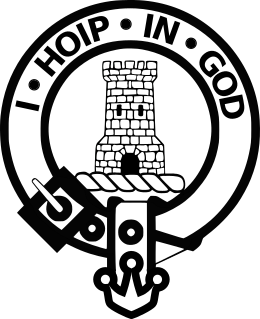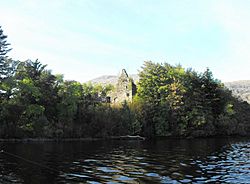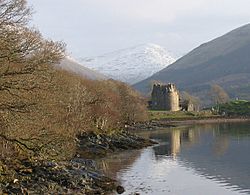Clan Macnaghten facts for kids
Quick facts for kids Macnaghten |
|||
|---|---|---|---|
| MacNeachdainn | |||

Crest: A castle embattled, Gules.
|
|||
| Motto | I hope in God | ||
| War cry | Fraoch Eilean meaning The Heathery Isle | ||
| Profile | |||
| Region | Strathtay, Lewis, Argyll, Galloway | ||
| District | Highland and Lowland | ||
| Plant badge | Trailing Azalea Proper | ||
| Chief | |||
 |
|||
| Sir Malcolm Francis MacNaghten of MacNaghten | |||
| baronet of Bushmills House | |||
| Seat | Dundarave House | ||
| Historic seat | Dundarave Castle | ||
|
|||
|
|||
|
|||
|
|||
Clan Macnaghten (also spelled MacNaughton or McNaughton) is a historic Scottish clan. In Scottish Gaelic, their name is MacNeachdain. This clan has a long and interesting history, connected to ancient Scottish rulers and important battles.
Contents
The Story of Clan Macnaghten
Where Did the Clan Come From?
Ancient Roots: Pictish Connections
The Macnaghten clan is one of several Scottish clans that believe they are related to the early Picts. The Picts were an ancient people who lived in Scotland a very long time ago. Some of their rulers were called "Mormaer of Moray." The name "Nectan" means pure or clear. It was a popular name among some Pictish royal families.
Early Records and a Special Castle
We have records of three brothers from the 1200s: Gilchrist, Athe, and Gilbert. They were all sons of Malcolm Macnachten. Before the year 1287, King Alexander III of Scotland gave Gilchrist a special document called a charter. This charter gave him the job of guarding a castle. This castle was on an island called Fraoch Eilean (which means "Heather Isle") in Loch Awe. This castle was important because it protected the eastern entrance to the narrow Pass of Brander, a key route to the west.
Fighting for Scotland's Freedom
When the Macnaghtens moved to Loch Awe, they became neighbors with the powerful Clan Campbell. The Campbells quickly supported Robert the Bruce when he wanted to become king of Scotland. However, the Macnaghtens were influenced by Clan MacDougall and at first, they were against Robert the Bruce.
The Macnaghtens fought with the MacDougalls against Robert the Bruce's army at the Battle of Dalrigh in 1306. But later, they changed their minds. By August 1308, they joined Bruce's side at the Battle of the Pass of Brander. The Macnaghtens continued to support Bruce. A leader called "Baron Macnachten" (who might have been Alexander Macnachten) is recorded fighting for Bruce at the famous Battle of Bannockburn in 1314. This battle was a big part of the Wars of Scottish Independence.
Even though they joined Bruce, the Macnaghtens didn't gain much power. From then on, the Campbells became the main power around Loch Awe.
Around 1360, Alexander Macnaghten's second wife, Christina Campbell, became a widow. In 1361, she gave away one-third of the Macnaghten lands. She did this to get protection from her cousin, Colin Campbell. Alexander Macnaghten's son, Duncan, inherited the rest of the lands. His main home became Dunderave Castle. This castle then became the official home of the clan chiefs.
Clan Life in the 1400s and 1500s
In 1478, Duncan's grandson, Alexander, accepted a charter from the Campbell Earls of Argyll. This meant he accepted the Campbells as his feudal superiors, or overlords. His grandson, also named Alexander, was made a knight by King James IV of Scotland. He went with the king to the Battle of Flodden in 1513. He was one of the few who survived that terrible battle. He died two years later. He had been married twice and had six sons. The oldest son became the new clan chief. His second son, Ian, had a son named Ian or "John Dhu." This John Dhu is thought to be the person who started the Macnaghten family in Ireland.
Gilbert Macnaghten became clan chief in 1548. He didn't have any children, so his younger brother, Alexander, took over. Alexander began rebuilding Dunderave Castle on Loch Fyne. His son, Iain, finished the castle in 1596.
The 1600s and Civil War
In 1627, the Macnaghten chiefs sent a group of skilled bowmen to help the French Huguenot rebels. These rebels were fighting in the Siege of La Rochelle. The chief of Clan Macnaghten was very well-liked by King Charles I of England. He even served as a Gentleman of the Privy Chamber (a special helper to the king). However, the cost of the French trip and living a fancy life at court made Macnaghten borrow a lot of money. He had to mortgage his lands.
Alexander died in 1630, and Dunderave Castle went to his brother, Malcolm Macnaghten. Malcolm's son was a Royalist, meaning he supported the king. He gathered his clan to fight against Oliver Cromwell in Glencairn's rising in 1653. After the king was restored to power in 1660, Macnaghten was made a knight. But because of the influence of the Campbell Earl of Argyll, he was later called a rebel. Because of this, the clan lost almost all their lands due to debt. The next chief, Iain, inherited very little, mostly just the title.
Iain joined the forces of John Graham, 1st Viscount Dundee and fought at the Battle of Killiecrankie in 1689. Because of this, he was called a Jacobite rebel. His remaining lands were taken away. His younger son, John Macnaghten, was the last chief of this direct line. John had to officially give away his last lands to Sir James Campbell in 1710.
Modern Times
In 1818, Edmund Alexander Macnaghten was recognized as the new clan chief. He was a descendant of the Irish branch of the Macnaghtens, who came from John Macnaughten "Shane Dhu" from the 1500s. Edmund Alexander Macnaghten passed away in 1832. His brother, Francis, took over as chief. Francis was a judge in India, working in Madras and Calcutta. He was a very good lawyer and later became a Lord of Appeal in 1887.
His son, Sir Edward, became chief after him. Sir Edward's two sons were both killed in World War I. So, their uncle, Sir Francis, became the eighth Baronet (a special title of honor).
Clan Chief
- The current Clan chief is Sir Malcolm MacNaghten of MacNaghten, Bt.
Clan Castles
Castles that belonged to the MacNaughtons or MacNaughts (a branch of the MacNaughtons) include:
- Dubh Loch Castle: This castle once stood by Loch Dubh, near Inveraray in Argyll. Now, only a mound remains. The clan made Dunderave their main home in the 1400s. Dubh Loch Castle was left empty, possibly because of an outbreak of the plague.
- Dundarave Castle: Not far from Dubh Loch Castle, this castle is three miles east of Inveraray on the north side of Loch Fyne. It's an L-shaped tower house that has been restored. It has a large round tower and was built in 1596. The last MacNaughton who owned the castle was Iain MacNaughton. He planned to marry the younger daughter of Sir James Campbell, but he was tricked into marrying the wrong woman. He then ran away to Ireland with the younger daughter he truly loved. The castle then went to the Campbells around 1689. Iain MacNaughton had also been a Jacobite, fighting at the Battle of Killiecrankie, which was another reason he couldn't stay. The castle became a ruin but was restored in 1911-12 for the Noble family. It is still lived in today. The MacNaughton family line continued, and they now live at Dundarave House in Bushmills, Antrim, Northern Ireland.
- Fraoch Eilean, Loch Awe: This is an island two miles north-east of Inveraray, Argyll. It has the ruins of what was once a strong castle with a hall house and courtyard. It was built in the 1100s or 1200s and was used for about 400 years. The MacNaughtons held it from 1267, but it later passed to the Campbells.

- Crogo: Ten miles north of Castle Douglas in Dumfries and Galloway, this was the site of a tower house in its own park. Nothing remains of it today. The MacNaughts owned these lands, but they went to the Gordons in the 1400s.
- Kilquhanty: Also north of Castle Douglas, this was the site of a castle or old house with its own park. The MacNaughts held these lands from 1360 to 1680. The current large house was built in 1820 and is now used as a school.
Clan Symbols


